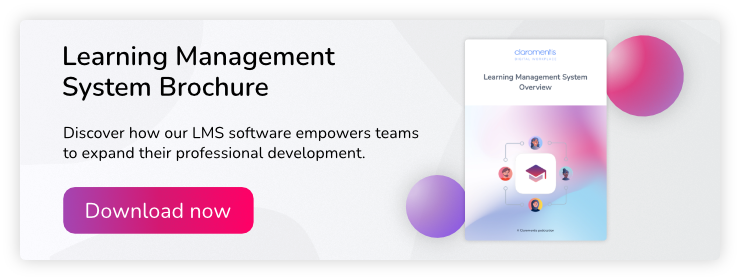Digital workplace learning has experienced an accelerated period of growth over the course of the pandemic, as businesses moved their learning initiatives from the classroom to online. In fact, the LMS (learning management system) market is forecast to grow at a CAGR of 19.1% over the next five years.
(Source: marketsandmarkets.com)
That said, digital learning at work is not a new concept, and usage was on the rise even before the phrase “Covid-19” was in people’s vocabulary.
According to figures on Statista, the percentage of UK individuals who participated in an online course grew from 4% in 2007 to 17% in 2019 – an increase of 325%. This huge rise can be largely attributed to the advancing learning technologies that enable engaging online training programmes for employees.
Indeed, many years ago, staff training usually involved a day out of work to attend a corporate training facility, or a day in a meeting room taking instructions from a travelling trainer. Either way, learning at work was never particularly engaging or inspiring, and often looked like something from an episode of The Office.
The dawn of online learning for employees, however, changed all that, turning lifeless workplace learning and skills development programmes into interactive, gamified, and engaging experiences.
Let’s learn a bit more about the differences between today’s digital workplace learning environments and the corporate training of yesteryear:
How does digital workplace learning differ from traditional company training?
Before online learning went mainstream, many companies relied on traditional methods of increasing staff skills, such as instructor-led training (ILT) by industry experts. Based at either an organisation’s offices or an external classroom, ILT involved a corporate trainer spending the day delivering presentations, handing out training materials, facilitating group workshops, and engaging in Q&As. Depending on the training course, there might be a written test or exam at the end.
There is nothing wrong with ILT per se – there are a lot of benefits that can be gained from an in-person classroom experience after all. But ILT does have its problems. For example:
- ILT requires people to attend either the office or an external training centre, which excludes a lot of staff if they’re not office-based or located nearby.
- Employees can’t revisit what they learned, unless the training materials with which they were provided are extensive or they took their own comprehensive notes.
- Entire days out of work are needed for ILT, which can be inflexible and disruptive to teams’ workloads, especially those whose jobs require frequent check-ins (such as customer support or team leaders).
- Similarly, full days’ worth of training may not generate the results your business is looking for. It’s a long period of time for people to maintain their full attention, and research by Learning Solutions Magazine shows that people forget 70% of what they learn within 24 hours – so staff may not be learning any new skills at all.
By comparison, digital workplace learning doesn’t require a rigid work location. Instead, all training content and teaching resources are accessible from an online learning ecosystem, usually via your company’s intranet platform. Here are some more key features:
- Because digital workplace learning tools are available from any device that has Wi-Fi connectivity and an internet browser, it puts your office-based, remote, and frontline workforce on an even playing field.
- Digital workplace learning utilises modern teaching methods and learning technologies such as gamification, which, according to a survey by Capterra, increases course content retention by 83%.
(Source: capterra.com)
- The technology allows team members to learn new skills at their own pace and at times that fit around their work schedule. This means that staff don’t need to block out whole days to attend a training course (or longer if they have to travel), putting them in charge of their own professional development process.
- Digital workplace learning can be customised to suit your organisation’s training needs, making it ideal for both formal and informal learning requirements.
What other benefits does digital workplace learning offer?
Your teams can get so much more out of a digital workplace learning platform than you may initially think. That’s because digital workplace learning doesn’t simply refer to a standalone LMS; it incorporates many other technologies that will supplement your teams’ professional development.
Here are a few examples:
- As we mentioned above, gamification technology plays a big part in improving employee learning. With that in mind, the best intranet software should include gamification technologies such as interactive quizzes, employee rewards, points systems, and certificates to tap into people’s desire to keep going and learn more.
- By using your digital workplace to manage employee learning, teams have instant access to additional training resources via other intranet apps, including knowledge management software and file sharing. This provides staff with a more holistic learning experience, which will help to improve course completion rates and employee engagement.
- Similarly, your digital workplace is also home to social intranet apps like internal communications feeds, corporate social networks, and internal intranet messengers, giving staff an arena to collaborate with their course mates or get in touch with their tutor directly.






